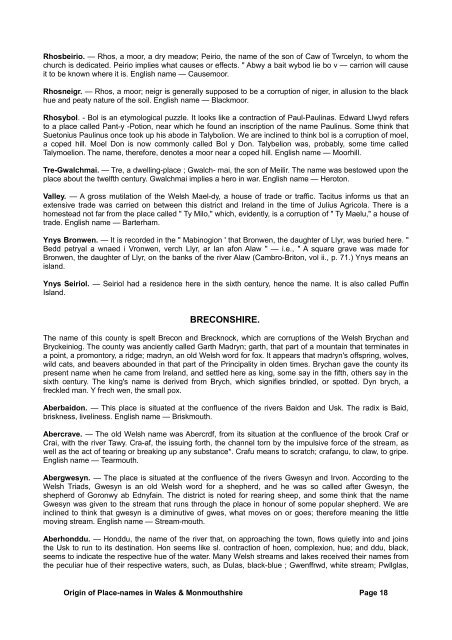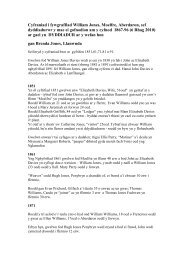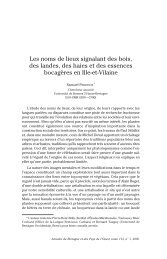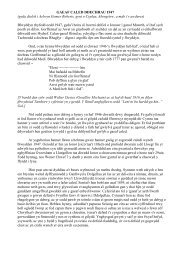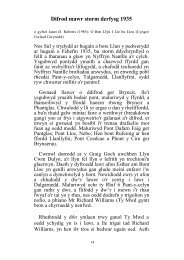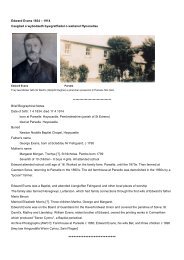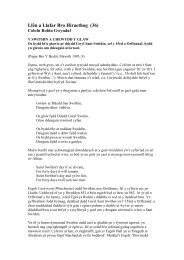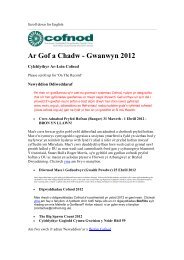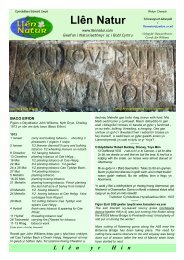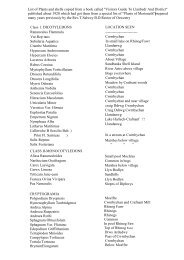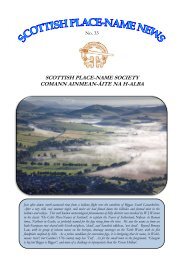Llangoed. — The name signifies a church <strong>in</strong> <strong>the</strong> wood, so called from <strong>the</strong> woody nature <strong>of</strong> <strong>the</strong>neighbourhood. The church was dedicated to Cawrdaf <strong>in</strong> <strong>the</strong> sixth century, <strong>and</strong> <strong>the</strong> parish is sometimescalled Llangawrdaf. English name — Churchwood.Llangristiolus. — Cristiolus, a descendant <strong>of</strong> Emyr Llydaw, flourished <strong>in</strong> <strong>the</strong> seventh century, <strong>and</strong> built <strong>the</strong>church which commemorated his name. Cristiolus signifies " <strong>the</strong> ano<strong>in</strong>ted." English name — Christchurch.Llanrhyddlad. — Rhuddlad, a daughter <strong>of</strong> <strong>the</strong> K<strong>in</strong>g <strong>of</strong> Le<strong>in</strong>ster, Irel<strong>and</strong>, was a sa<strong>in</strong>tess <strong>of</strong> <strong>the</strong> seventhcentury, <strong>and</strong> <strong>the</strong> supposed founder <strong>of</strong> <strong>the</strong> above church. One author th<strong>in</strong>ks <strong>the</strong> right word<strong>in</strong>g is Rhyddlad;rhydd, at liberty, free; lad-gwlad, country. Perhaps <strong>the</strong> prefix is rhudd, red; <strong>the</strong> name, <strong>the</strong>refore, means redsoil or country. English name — Redham.Llantrisant. — The church is dedicated to tri sant, three sa<strong>in</strong>ts: Afren, Ieuan, <strong>and</strong> Savan, who, it issupposed, founded it <strong>in</strong> <strong>the</strong> year 570. English name- Triton.Llechylched. — Some th<strong>in</strong>k <strong>the</strong> church is dedicated to Ilched or Ylched. The name is, probably, a compound<strong>of</strong> Llech, a flat stone ; <strong>and</strong> cylched, a circumference, what goes about or encloses. Cylchedu, to encircle, to<strong>in</strong>clude <strong>in</strong> a circle. Perhaps <strong>the</strong> name has reference to <strong>the</strong> Druidical circle stones. English name —Circumstone.Menai Bridge. — The Welsh name is Porthaethwy which is variously derived. The late Rev. P. B. Williamswrites: — " This ferry, probably, took its name from <strong>the</strong> hundred or division <strong>in</strong> which it is situated -T<strong>in</strong>daethwy. Porth, port, a ferry<strong>in</strong>g <strong>place</strong>; - T<strong>in</strong>daethwy, accord<strong>in</strong>g to some, is a contraction <strong>of</strong> aeth or aethanty went ; <strong>and</strong> hwy - <strong>the</strong>y, signify<strong>in</strong>g <strong>the</strong> ferry over <strong>the</strong> strait which <strong>the</strong>y — <strong>the</strong> first settlers <strong>of</strong> Mona — crossedto <strong>the</strong> o<strong>the</strong>r side. Iago Emlyn derives aethwy thus: Aeth, terrible; wy-gwy, water; found<strong>in</strong>g his reason on <strong>the</strong>perilousness <strong>of</strong> <strong>the</strong> passage across <strong>the</strong> straits. Ano<strong>the</strong>r writer th<strong>in</strong>ks it is Porth-y-caeth-wy, <strong>the</strong> port <strong>of</strong> <strong>the</strong>narrow water. The <strong>place</strong> has been popularly called Menai Bridge ever s<strong>in</strong>ce <strong>the</strong> construction <strong>of</strong> <strong>the</strong> worldrenownedbridge that spans <strong>the</strong> straits. Menai comes from Ma<strong>in</strong> -aw, which signifies <strong>the</strong> narrow water; or itmight be ma<strong>in</strong>-wy, which means <strong>the</strong> same.Moelfre. — A very common <strong>place</strong>-name <strong>in</strong> Wales. It is a compound <strong>of</strong> Motl y bare, bald ; <strong>and</strong> bre, a hill, amounta<strong>in</strong>. The name is generally applied to a treeless hill, but covered with short, smooth grass, sometimes<strong>in</strong>terspersed with heath. English name — Baldhill.Nebo. — This village takes its name from a Nonconformist chapel <strong>in</strong> <strong>the</strong> <strong>place</strong>.Niwbwrch, or Newborough. — Its ancient name, accord<strong>in</strong>g to some, was Rhosfair, from a small churchdedicated to St. Mary. Mr. Rowl<strong>and</strong>s th<strong>in</strong>ks <strong>the</strong> name was Rhos Hit, long meadow, from its situation <strong>in</strong> anextensive marshy pla<strong>in</strong> on <strong>the</strong> eastern side. The <strong>place</strong> was once <strong>the</strong> capital <strong>of</strong> Mona, <strong>and</strong> <strong>the</strong> residence <strong>of</strong><strong>the</strong> pr<strong>in</strong>ces <strong>of</strong> North Wales. Edward I. made it a free corporation, from which circumstance <strong>orig<strong>in</strong></strong>ated <strong>the</strong>present name <strong>of</strong> Newborough. Niwbwrch is probably a corruption <strong>of</strong> Newborough.Pencarneddi. — Pen, head, top, end ; Carneddi, a plural form <strong>of</strong> Carnedd, which denotes a sepulchral heap<strong>of</strong> stones. Carneddau were <strong>the</strong> common monuments erected by <strong>the</strong> ancient Britons <strong>in</strong> honour <strong>of</strong> <strong>the</strong>ir greatmen. English name — Cairnham.Penmynydd. — The name signifies mounta<strong>in</strong> top, <strong>and</strong> was given to <strong>the</strong> village from respect to <strong>the</strong> mansion<strong>of</strong> <strong>the</strong> same name, which is famous for be<strong>in</strong>g <strong>the</strong> <strong>place</strong> where Owa<strong>in</strong> Tudor was born <strong>in</strong> 1384. English name— Montham.Pensarn. — Pen, head, end; Sam, Roman paved road, a causeway. A name <strong>of</strong> frequent occurrence <strong>in</strong>Welsh topography. English name— Roadsend.Pentraeth. — The parish is also called Llanfair- Bettws-Gera<strong>in</strong>t. The church was dedicated to St. Mary about<strong>the</strong> sixth century, <strong>and</strong> supposed to have been built by Gera<strong>in</strong>t or Gerimius, gr<strong>and</strong>son <strong>of</strong> Constant<strong>in</strong>e. Thevillage is called Pentraeth, from its be<strong>in</strong>g situated at <strong>the</strong> head or upper end <strong>of</strong> <strong>the</strong> s<strong>and</strong>y beach, or bay, whichis called Traethcoch or Red Wharf Bay. English name — Beachend.Pontripont. — A corruption, probably, <strong>of</strong> Pontrhyd- y-bont. The ancient name was Rhydpont, or Rhyd-y-bont,<strong>the</strong> fori <strong>of</strong> <strong>the</strong> bridge. The prefix pont was probably added when ano<strong>the</strong>r bridge was built across Rhydybont.English name — Bridgeford.Orig<strong>in</strong> <strong>of</strong> Place-<strong>names</strong> <strong>in</strong> Wales & Monmouthshire Page 17
Rhosbeirio. — Rhos, a moor, a dry meadow; Peirio, <strong>the</strong> name <strong>of</strong> <strong>the</strong> son <strong>of</strong> Caw <strong>of</strong> Twrcelyn, to whom <strong>the</strong>church is dedicated. Peirio implies what causes or effects. " Abwy a bait wybod lie bo v — carrion will causeit to be known where it is. English name — Causemoor.Rhosneigr. — Rhos, a moor; neigr is generally supposed to be a corruption <strong>of</strong> niger, <strong>in</strong> allusion to <strong>the</strong> blackhue <strong>and</strong> peaty nature <strong>of</strong> <strong>the</strong> soil. English name — Blackmoor.Rhosybol. - Bol is an etymological puzzle. It looks like a contraction <strong>of</strong> Paul-Paul<strong>in</strong>as. Edward Llwyd refersto a <strong>place</strong> called Pant-y -Potion, near which he found an <strong>in</strong>scription <strong>of</strong> <strong>the</strong> name Paul<strong>in</strong>us. Some th<strong>in</strong>k thatSuetonius Paul<strong>in</strong>us once took up his abode <strong>in</strong> Talybolion. We are <strong>in</strong>cl<strong>in</strong>ed to th<strong>in</strong>k bol is a corruption <strong>of</strong> moel,a coped hill. Moel Don is now commonly called Bol y Don. Talybelion was, probably, some time calledTalymoelion. The name, <strong>the</strong>refore, denotes a moor near a coped hill. English name — Moorhill.Tre-Gwalchmai. — Tre, a dwell<strong>in</strong>g-<strong>place</strong> ; Gwalch- mai, <strong>the</strong> son <strong>of</strong> Meilir. The name was bestowed upon <strong>the</strong><strong>place</strong> about <strong>the</strong> twelfth century. Gwalchmai implies a hero <strong>in</strong> war. English name — Heroton.Valley. — A gross mutilation <strong>of</strong> <strong>the</strong> Welsh Mael-dy, a house <strong>of</strong> trade or traffic. Tacitus <strong>in</strong>forms us that anextensive trade was carried on between this district <strong>and</strong> Irel<strong>and</strong> <strong>in</strong> <strong>the</strong> time <strong>of</strong> Julius Agricola. There is ahomestead not far from <strong>the</strong> <strong>place</strong> called " Ty Milo," which, evidently, is a corruption <strong>of</strong> " Ty Maelu," a house <strong>of</strong>trade. English name — Barterham.Ynys Bronwen. — It is recorded <strong>in</strong> <strong>the</strong> " Mab<strong>in</strong>ogion ' that Bronwen, <strong>the</strong> daughter <strong>of</strong> Llyr, was buried here. "Bedd petryal a wnaed i Vronwen, verch Llyr, ar Ian afon Alaw " — i.e., " A square grave was made forBronwen, <strong>the</strong> daughter <strong>of</strong> Llyr, on <strong>the</strong> banks <strong>of</strong> <strong>the</strong> river Alaw (Cambro-Briton, vol ii., p. 71.) Ynys means anisl<strong>and</strong>.Ynys Seiriol. — Seiriol had a residence here <strong>in</strong> <strong>the</strong> sixth century, hence <strong>the</strong> name. It is also called Puff<strong>in</strong>Isl<strong>and</strong>.BRECONSHIRE.The name <strong>of</strong> this county is spelt Brecon <strong>and</strong> Brecknock, which are corruptions <strong>of</strong> <strong>the</strong> Welsh Brychan <strong>and</strong>Brycke<strong>in</strong>iog. The county was anciently called Garth Madryn; garth, that part <strong>of</strong> a mounta<strong>in</strong> that term<strong>in</strong>ates <strong>in</strong>a po<strong>in</strong>t, a promontory, a ridge; madryn, an old Welsh word for fox. It appears that madryn's <strong>of</strong>fspr<strong>in</strong>g, wolves,wild cats, <strong>and</strong> beavers abounded <strong>in</strong> that part <strong>of</strong> <strong>the</strong> Pr<strong>in</strong>cipality <strong>in</strong> olden times. Brychan gave <strong>the</strong> county itspresent name when he came from Irel<strong>and</strong>, <strong>and</strong> settled here as k<strong>in</strong>g, some say <strong>in</strong> <strong>the</strong> fifth, o<strong>the</strong>rs say <strong>in</strong> <strong>the</strong>sixth century. The k<strong>in</strong>g's name is derived from Brych, which signifies br<strong>in</strong>dled, or spotted. Dyn brych, afreckled man. Y frech wen, <strong>the</strong> small pox.Aberbaidon. — This <strong>place</strong> is situated at <strong>the</strong> confluence <strong>of</strong> <strong>the</strong> rivers Baidon <strong>and</strong> Usk. The radix is Baid,briskness, livel<strong>in</strong>ess. English name — Briskmouth.Abercrave. — The old Welsh name was Abercrdf, from its situation at <strong>the</strong> confluence <strong>of</strong> <strong>the</strong> brook Craf orCrai, with <strong>the</strong> river Tawy. Cra-af, <strong>the</strong> issu<strong>in</strong>g forth, <strong>the</strong> channel torn by <strong>the</strong> impulsive force <strong>of</strong> <strong>the</strong> stream, aswell as <strong>the</strong> act <strong>of</strong> tear<strong>in</strong>g or break<strong>in</strong>g up any substance*. Crafu means to scratch; crafangu, to claw, to gripe.English name — Tearmouth.Abergwesyn. — The <strong>place</strong> is situated at <strong>the</strong> confluence <strong>of</strong> <strong>the</strong> rivers Gwesyn <strong>and</strong> Irvon. Accord<strong>in</strong>g to <strong>the</strong>Welsh Triads, Gwesyn is an old Welsh word for a shepherd, <strong>and</strong> he was so called after Gwesyn, <strong>the</strong>shepherd <strong>of</strong> Goronwy ab Ednyfa<strong>in</strong>. The district is noted for rear<strong>in</strong>g sheep, <strong>and</strong> some th<strong>in</strong>k that <strong>the</strong> nameGwesyn was given to <strong>the</strong> stream that runs through <strong>the</strong> <strong>place</strong> <strong>in</strong> honour <strong>of</strong> some popular shepherd. We are<strong>in</strong>cl<strong>in</strong>ed to th<strong>in</strong>k that gwesyn is a dim<strong>in</strong>utive <strong>of</strong> gwes, what moves on or goes; <strong>the</strong>refore mean<strong>in</strong>g <strong>the</strong> littlemov<strong>in</strong>g stream. English name — Stream-mouth.Aberhonddu. — Honddu, <strong>the</strong> name <strong>of</strong> <strong>the</strong> river that, on approach<strong>in</strong>g <strong>the</strong> town, flows quietly <strong>in</strong>to <strong>and</strong> jo<strong>in</strong>s<strong>the</strong> Usk to run to its dest<strong>in</strong>ation. Hon seems like sl. contraction <strong>of</strong> hoen, complexion, hue; <strong>and</strong> ddu, black,seems to <strong>in</strong>dicate <strong>the</strong> respective hue <strong>of</strong> <strong>the</strong> water. Many Welsh streams <strong>and</strong> lakes received <strong>the</strong>ir <strong>names</strong> from<strong>the</strong> peculiar hue <strong>of</strong> <strong>the</strong>ir respective waters, such, as Dulas, black-blue ; Gwenffrwd, white stream; Pwllglas,Orig<strong>in</strong> <strong>of</strong> Place-<strong>names</strong> <strong>in</strong> Wales & Monmouthshire Page 18
- Page 1 and 2: HANDBOOK OF THE ORIGIN OF PLACE-NAM
- Page 3 and 4: § § § § §The Author begs to st
- Page 5 and 6: pitiful cries of the railway offici
- Page 7 and 8: Bishop Percy says that "in England,
- Page 9 and 10: The city of Chester is still popula
- Page 11 and 12: There's Cumwhitton, Cumwhinton, Cum
- Page 13 and 14: Llwyn in its primary' sense means a
- Page 15 and 16: PLACE-NAMES IN WALES.Wales. — The
- Page 17 and 18: Church are generally dedicated to e
- Page 19: think he was a contemporary of St.
- Page 23 and 24: of Brecknock," states that this vic
- Page 25 and 26: Cam cnwir ef Cwmdu,Cwm gwyn yw & n
- Page 27 and 28: Penderyn. — A corruption probably
- Page 29 and 30: Ardudwy. — Ar, upon or above; tud
- Page 31 and 32: to mark its pre-eminence over the o
- Page 33 and 34: Some think that eirw is a corruptio
- Page 35 and 36: present form — Caerfyrddin.Abergw
- Page 37 and 38: place of refuge; hence the name. En
- Page 39 and 40: Llansawyl. — The church was dedic
- Page 41 and 42: eject. The village took its name fr
- Page 43 and 44: house, and attempted to kill an inf
- Page 45 and 46: Gwydir. — Prima facie one may tak
- Page 47 and 48: Nefyn. — The church was probably
- Page 49 and 50: DENBIGHSHIRE.Anglicized form of Din
- Page 51 and 52: Llangollen. — From Collen, a sain
- Page 53 and 54: hands into their pockets to pay a c
- Page 55 and 56: Cefn. — The name signifies a ridg
- Page 57 and 58: Maesgarmon. — Named in honour of
- Page 59 and 60: Abertridwr. — Tridwr, three water
- Page 61 and 62: it is said, was originally built by
- Page 63 and 64: Cwmllynfell. — Cwm, a narrow vale
- Page 65 and 66: Gwarycaeau. — Gwdr, the nape of t
- Page 67 and 68: means a cultivated region, a vale,
- Page 69 and 70: Penrhiwfer.- Pen, head, top; rhiw,
- Page 71 and 72:
Port Talbot. — So called in 1835
- Page 73 and 74:
Trealaw. — This appellation was g
- Page 75 and 76:
Aberdyfi. — So called from its si
- Page 77 and 78:
Llanddwywe. — From Dwywau, a desc
- Page 79 and 80:
Crickhowell and some in the directi
- Page 81 and 82:
Griffithstown. — This village was
- Page 83 and 84:
and gwy, water. Treiddiod troth tna
- Page 85 and 86:
derive Tintern from din, fortified
- Page 87 and 88:
Caersws. — It appears that the Ro
- Page 89 and 90:
English name — Ervylton.Llanymech
- Page 91 and 92:
Angle. — Probably from the angle-
- Page 93 and 94:
Gellyswick. — Another hybrid. Gel
- Page 95 and 96:
that the two rivers in their flowin
- Page 97 and 98:
ecame the bishop of the see, and wa
- Page 99 and 100:
earth formerly stood on a summit on
- Page 101 and 102:
Pilleth. — A corruption of pwll,
- Page 103 and 104:
Howells, Rev. J., Mountain AshHowel
- Page 105 and 106:
Williams, D., PenywernWilliams, Rev


